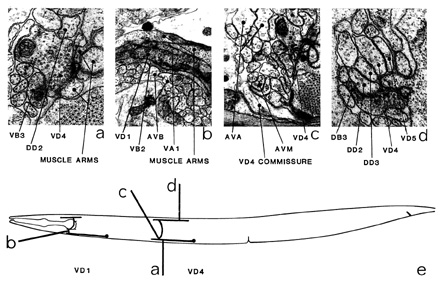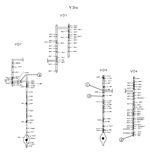VDn is a set of thirteen motoneurons, with cell bodies in the ventral cord, which innervate
ventral muscles. Each cell has an anteriorly directed process emanating from its cell body. This
process has a branch, which leaves the ventral cord on the right as a commissure (c) and runs
round to the dorsal cord. (VD2 is exceptional; it has a left-hand commissure.) The commissure
splits, as it enters the dorsal cord, into an anteriorly and a posteriorly directed process, which
span approximately the same region of the body as their ventral counterparts (e). (VD1 is
exceptional in that its dorsal process is anterior to its ventral counterpart.) Both the dorsal and
the ventral processes run adjacent to the basal lamina bounding the cord, in close association
with the processes of DDn neurons. The ventral process lies between the processes of VCn dorsally and the other motoneuron classes ventrally (figure 18). The dorsal process runs
ven trally to the other motoneuron axons (figure 19). The VDn processes in the dorsal cord
are exclusively postsynaptic, receiving synaptic input from DAn (*a), DBn (*a) and ASn (*a)
motoneurons at points where they have NMJs. The processes in the ventral cord are
predominantly presynaptic and have many NMJs (a, b), most of which have only muscle as
the postsynaptic partner. The processes of VDn and DDn do not have extended, apparently
undifferentiated distal regions, as do the other motoneuron classes; instead, they end abruptly
in close proximity to the end of a neighbouring process of the same class, often with a gap
junction between them (d). VDn also has gap junctions to DDn and a few with PVP. VD1 has several additional Œodd¹ gap junctions.
Magnifications: (a, d) x 25500, (b) x 12750, (c) x 17000.

Click pictures for higher resolution images

